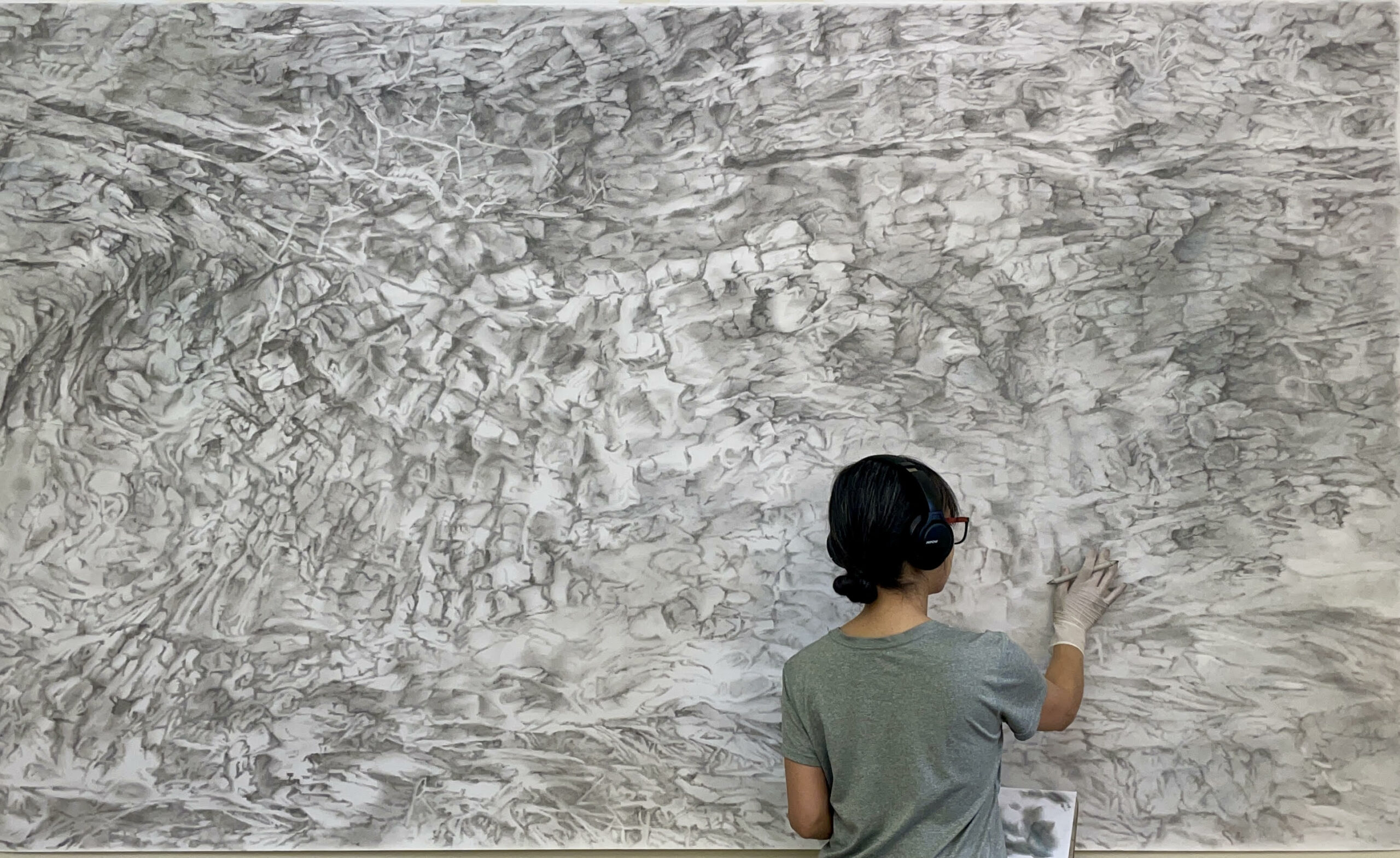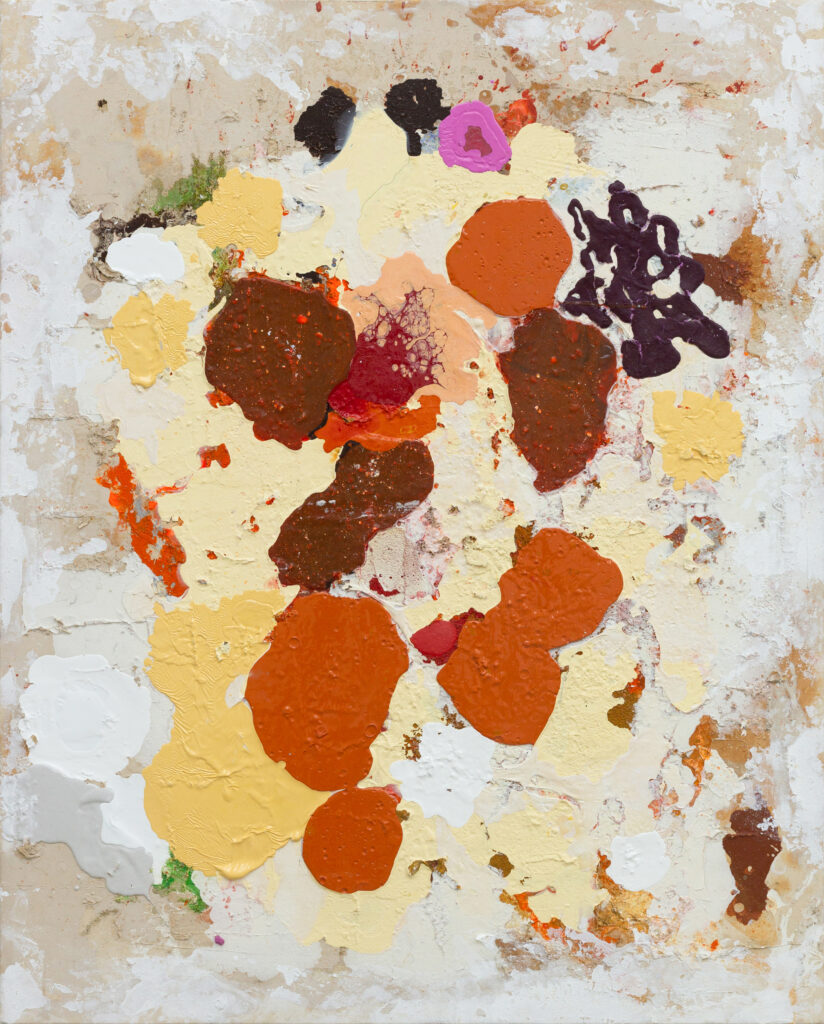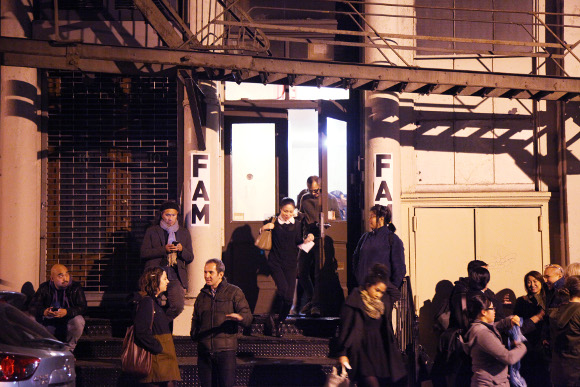Katrina Bello’s exquisite drawings of the vast and the miniscule in nature

March 30, 2023
This piece is part of the Climate notebook, which features art by Katrina Bello.
A large drawing of willow bark that resembles cliffs and canyons. A drawing of bare treetops in the shape of a decaying leaf small enough to hold in your hands. Small depictions of water in shapes resembling islands. In these pieces and much of her work, visual artist Katrina Bello presents natural textures and shapes as both familiar and strange. Across her portfolio of drawings, videos, and animations, Bello shows the environment as a space of many contrasts—stillness and motion, the vast and the miniscule. Working in both large and small formats, Bello creates work of exquisite, precise detail using charcoal, pastel, acrylic, and graphite, among other materials.
This spring we paired Bello’s work with The Margins’ Climate notebook, which includes poems, essays, speeches, reportage, and letters that reckon with our dialogue around climate change. We were drawn to how Bello’s work, which feels both telescopic and microscopic, resonates with the questions of scale and time that surface in the notebook. Her pieces often invite viewers to contemplate their own size and power in relation to the landscapes depicted. While some of her art invites us to feel in the presence of something vast and larger than us, other pieces position us as the ones with the power to change our environment, which, as Bello says, is “something that is fragile, precious, and in need of care.”
Bello was born in Davao City and now works in New Jersey in the United States and in Metro Manila in the Philippines. She has participated in solo and group exhibitions in the Philippines and the US, where she has also been awarded fellowships and residencies. Bello is the founder of north willow, an informal artist-run attic exhibition space in Montclair, New Jersey. Her website is katrinabello.com. Find her on Instagram @kimbells2037.
Below is an interview we conducted with Bello on her work and thinking.
The Margins
You write that you are interested in drawing “landscapes of wildernesses.” What does wilderness mean to you?
Katrina Bello (KB)
I feel that the wilderness is the “other” of our human world. It is the one that reminds us of our limitations, what is important, and what we cannot control. It’s full of wonders that put us in awe. At the same time, the current state of our remaining wildernesses seem to be in a precarious and fragile position, being subject to human interventions such as increasing urbanization, being tapped for natural resources, and habitat loss for many creatures.
I became interested in the idea of the wilderness—as well as nature in general—as our “other” after I came across the idea from a 2007 lecture on Gilles Deleuze’s work given by philosopher Manuel DeLanda at the European Graduate School. In the lecture, DeLanda spoke of Deleuze’s works on nonhuman expressivity. He gave examples such as crystals, rock striations, and geological events like volcanic explosions and tectonic plate movements that dramatically change our landscape in very slow times scales—all part of the idea that expressivity is not solely possessed by humans, and that even inorganic things can express their identity through their forms. DeLanda further explains that for Deleuze, if we focus only on things that are human and the creations by humans, we lose sense of our “otherness”—referring to the nonhuman. This idea of otherness and nonhuman expressivity were significant revelations to me, and made me reexamine how I perceive the wilderness and the natural world, and especially how to represent them in my work, particularly in my drawings.
The Margins
There’s a real sense of tactility and touch in a lot of your work—seeing the texture of puma fur or magnolia bark so exquisitely drawn makes the natural world seem strange but also more touchable, and in a way, knowable. What do you think we can feel or know about the natural world by seeing its textures instead of its whole—the puma fur instead of the whole puma, the magnolia bark instead of the full tree?
KB
When a viewer tells me that they get a sense of tactility and touch in the work, I feel grateful that some of my intentions for the work are successfully communicated and felt by the viewer. It’s because touch and tactility are the heart of my drawing process, especially in my large drawings, and I want to share it with the viewer. Touch plays a significant role in my large drawings: they are made with soft pastels that I crush into a powder and apply on the paper with my hands, rubbing the powder vigorously using my palms on the paper’s surface, and using my fingertips to make details. The paper is mounted on a wall, and so in this process of working, my face and body are mere inches away from the paper’s surface while I press the pigment onto the surface with my hands and fingers. Perhaps one can describe it as an intimate process.
And likewise with the subject of the work, touching is a very large component too. Touching things I find in my landscape explorations and looking at them up close reveal a whole otherworldly landscape: patterns on rocks and tree bark—like the magnolia tree—that appear like remote otherworldly terrains. In the case of the puma fur (to be precise, the reference is the critically endangered Florida panther), looking up close on the surface of the puma fur, I imagine seeing what appears like an expanse of the grasslands of the Florida panther’s dwindling habitat.
In addition to looking at things closely, I feel that touch is even more integral to my work; I think it is my process of knowing and having a stronger connection to landscape and the things that belong there. I did not fully examine and understand the role that touch plays in my work until it was pointed out to me by my graduate school director at Maryland Institute College of Art, Zlata Baum. She recommended I read Finnish architect Juhani Pallasmaa’s Eyes of The Skin: Architecture and the Senses. The text shed light on what I felt I was doing. Pallasmaa mentioned touch as the “mother of the senses.” In the book’s introduction, he wrote: “Touch is the sensory mode that integrates our experience of the world with ourselves.… My body is truly the navel of my world, not in the sense of the viewing point of the central perspective, but as the very locus of reference, memory, imagination and integration.”
The Margins
How do you see the idea of migration surfacing in your work?
KB
The idea of migration surfaces in my works through my subjects and images that refer to land and sea. When I migrated to the United States from the Philippines where I was born and raised, it was unexpected. I was unprepared to leave my native homeland to which I had a very strong connection, especially to the coastal landscapes of the city of my birth, Davao. My acts of remembering these landscapes have become more overactive as I live longer and grow older in my adopted country. As my memories of these landscapes start to fade, my drawings start to look hazy, lose color, and turn dark gray—the color of the sea near my childhood home in Davao, a sea that is darkened by black sand. Davao City lies on the foot of a presumably extinct volcano, the largest in the country, and the soil of the surrounding areas is likely made from eroded volcanic material. I seem to recall that no matter how much cleaning we did, grains of this black sand were always around us: in our homes, clothes, between the pages of our school books, our pockets, and even in our food and hair. Perhaps this development in my work can be attributed to longing and nostalgia for the native homeland that I left when I migrated.
The Margins
You describe creating works so a viewer might “get a sense of either being enveloped and surrounded by this space, or the sense that they can hold it in the palm of their hand.” Why do you think this is important?
KB
Making work that is extreme in size and scale feels important to me because the subject of the work also has a similar sense of feeling either very large or very small. My subjects relate to nature, the environment, migration, memory, landscapes and the experience of these landscapes. And for me, these all have an overwhelming sense of being vast and ungraspable. Just as a desert or body of water can feel enormous, so do the scale of environmental issues that we are currently dealing with such as global warming, ocean pollution, deforestation, and more. So when I work on my large drawings that are mounted on the wall, it feels as if the large paper is enveloping me, and the subject of the work is enveloping me too. It’s a feeling that I hope to share with the viewer.
On the other hand, I also make the opposite: the very small drawings that can fit in one’s hands. So just as our experience of, say an ocean, is in the presence of something vast and much larger than us, at the same time when we look at and observe tiny things we find on the beach like stones and seashells, we are in the presence of something small. When I make these very small drawings based on oceans and landscapes, it is intended to communicate the sense that it is also something that is fragile, precious, and in need of care. Therefore I count on size and scale as my form of insistence on the subject of the works.
The Margins
What guides your decision to frame some pieces and not others? (I’m looking at the photos of your Drawing Abundance exhibit.)
KB
There are logistical reasons for it. But also, the choices and decisions made sense to emphasize the scale and subjects of the works in the show. The small drawings in the Drawing Abundance exhibition were based on a forest of cottonwood and aspen trees I encountered in southeast Wyoming, and they are drawn in the shape and size of the interior of one’s palm. The series is the smallest drawings I’ve ever made, and in framing them, I hoped to emphasize the smallness of the work as well as the fragility of forest wildernesses. With the large drawings, which were based on the bark of cottonwood and willow trees, in not framing them, I hoped to emphasize their qualities as strange vast landscapes that feel boundless. The large drawings also have a more pronounced texture than the smaller ones, and therefore it is better to exhibit them with the surfaces exposed so that the viewer can examine them up close.
The Margins
What are you working on now?
KB
I’m working on an ongoing series of large drawings titled 30,000 Tons. The series is based on ocean waters, and the title refers to the volume of water that falls on earth annually in the form of cometary particles from space, according to the book Earth: A Very Short Introduction by Martin Redfern. I’m also working on a series of ongoing videos that are part of my Hawak/Hold drawing series.



